In Midway Museum, Rockford, Illinois, you will find a permanent exhibition of red-mouthed sock monkeys. Guy Lochhead explores the origins of this toy, ingeniously upcycled from red-heeled socks
In 1852 a Swedish machinist named John Nelson emigrated to Rockford, Illinois to start a woodworking factory, but became distracted by the idea of a new sock-making process that didn’t leave an uncomfortable seam along the heel. In fact, he became so obsessed with the idea that, for a time, his friends worried he was mad. Fortunately, with the help of a local inventor, he finalised a design for his sock-knitting machine.
The socks proved popular with farmers and factory workers and spawned many imitations, also known as Rockfords. To set the original Rockfords apart, Nelson Knitting Co patented the iconic red heel in 1915.
During the Great Depression, impoverished American mothers would turn old Rockford socks into toy monkeys, using the red heel as the doll’s mouth. The craze grew, and in 1955, Nelson Knitting Co was awarded the patent of the monkey pattern, and began including monkey-making instructions with every pair of socks sold.
The company was bought out by Fox River Mills in 1992, who continue to produce the socks, largely unchanged but for getting rid of the toe seam that was previously turned into the monkeys’ eyebrows.
Rockfords have been worn by Albert Einstein, Ansel Adams and JFK – and New York gallery director Ron Warren is credited with having the largest collection of homemade sock monkeys, which was the subject of a book called Sock Monkeys (200 Out Of 1,863) by Arne Svenson.


































